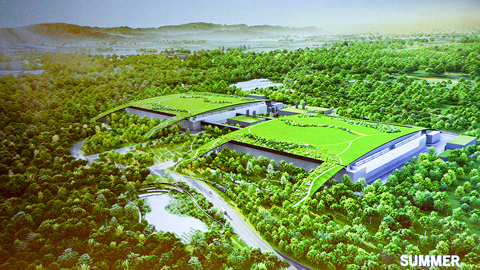Return to Construct Hokkaido(More articles in English here.)
Rapidus’ Hokkaido Valley Concept Centered on Chitose Semiconductor Plant
On May 22, Atsuyoshi Koike, president of Rapidus Corporation (headquartered in Tokyo), announced the company’s Hokkaido Valley project. It will center on a new next-generation semiconductor plant to be built in Chitose City, while Tomakomai, Chitose, Sapporo, and Ishikari cities will form a broad base for DX and GX. The company envisions to create a hub for the development of Japan’s next-generation products here. It intends to establish a Hokkaido semiconductor center that will include residential, educational, commercial and medical functions, and to promote sustainable town development through the cultivation of human resources in the advanced semiconductor field through industry-academia-government collaboration in Japan, the U.S. and Europe.

President Koike presented an outline at a briefing organized by the company, Chitose City and the Hokkaido Government. The plant will be built in Chitose Bibi World, an industrial park in Chitose City. Kajima Corporation is responsible for design and construction of the plant, and land development will begin in June, while the pilot line is slated to start operations in 2025.
The proposed Valley Concept covers an area including Tomakomai port with its potential linkage to an international submarine cable, Chitose City with its semiconductor industry and airport, Sapporo City, a communications network center, and Ishikari City where data centers utilizing 100% renewable energy are being accumulated. Modeled after IBM’s NY CREATES in Albany, U.S.A., the Hokkaido semiconductor center will include residential, educational, commercial and medical functions surrounding the development base. President Koike said that discussions are underway with Governor Naomichi Suzuki and others.
Rapidus executives outlined the construction schedule for the new plant. Land development will begin in June and is expected to be completed by January 2024. Plant construction will start in 2023 with piling in September, earthwork in October, and foundation work and seismic isolation from October to August 2024. The framework will be constructed from January to December 2024, and work on the roof and exterior will proceed as progress is made. Equipment will be brought in from December 2024, and the pilot line is expected to start operation in April 2025. Exterior construction will proceed from April 2024 to May 2025.
Concerning the foreseen number of workers, the general manager of Kajima’s IIM-1 construction planning and construction office said, “We expect to have 2,000 workers under peak construction conditions and 4,000 workers at the peak period of equipment installation.”
During the construction process, the remaining soil will be diverted within Chitose Bibi World to ensure that the plant is in harmony with nature. Environmentally friendly concrete and blast-furnace slag cement will be used, and precast construction will be carried out using precast materials manufactured in Hokkaido.
At the new Chitose plant, 2㎚ semiconductors will be manufactured. President Koike presented a new manufacturing business model, RUMS, for the first time. The idea is to focus on process speed and efficient manufacturing. The president outlined the feature of semiconductors to provide high performance at low power, and added that approximately 1,000 employees would work there once the plant is up and running.
Hokkaido Vice Governor Shunsuke Tsuchiya also announced that the course to be followed to promote the digital industry in Hokkaido will be formulated in the summer.
(Excerpt from an article on May 23, 2023)
メニュー

